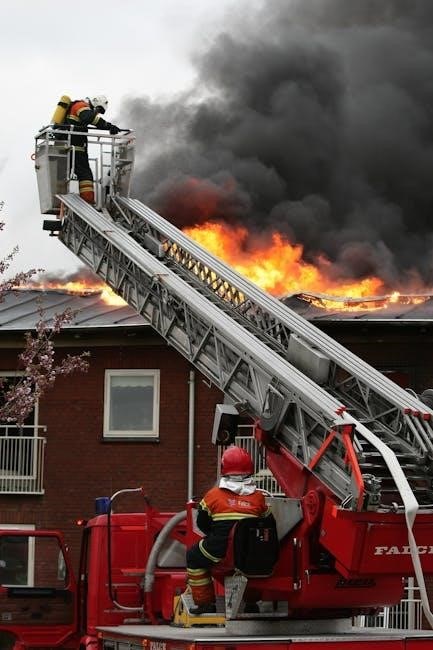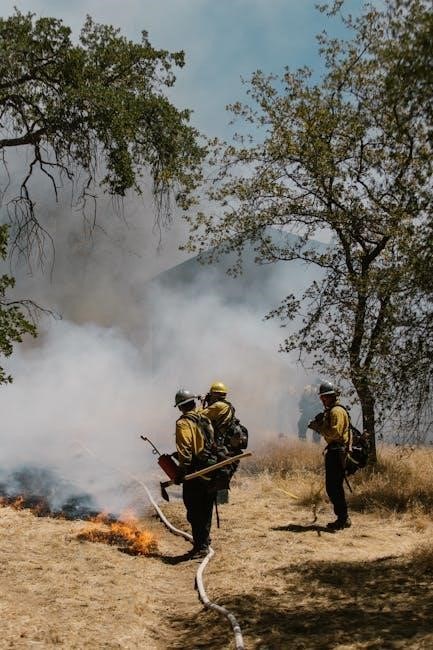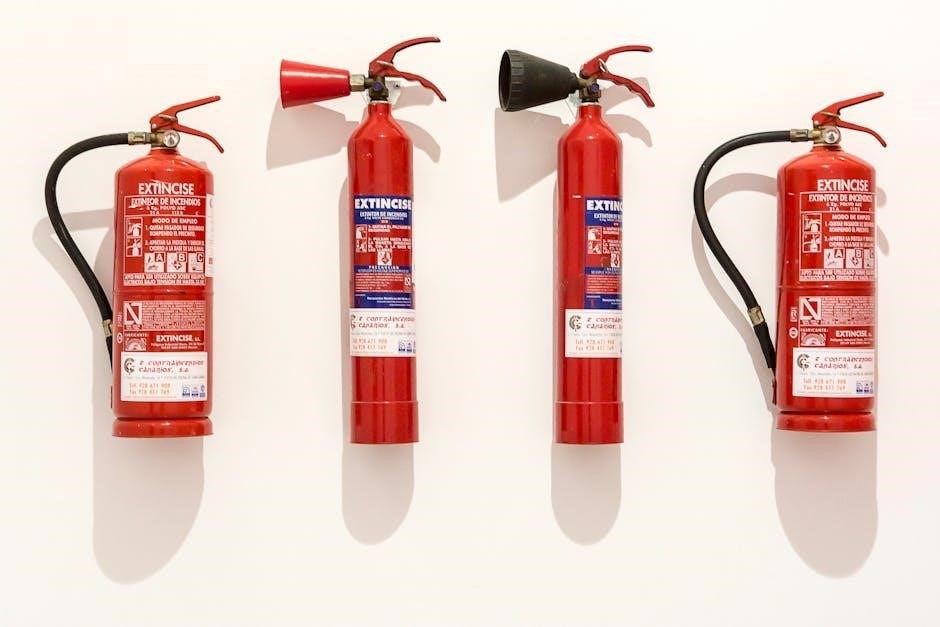
fire protection guide to hazardous materials pdf free download
Fire protection involves strategies to prevent, control, and mitigate fires involving hazardous materials. This guide provides essential insights into managing risks, ensuring safety, and adhering to standards.
1.1 Definition and Classification of Hazardous Materials
Hazardous materials are substances posing risks to health, safety, or the environment. They are classified into categories like flammable liquids, gases, oxidizers, corrosives, and toxics. Proper classification, based on global standards like NFPA 704, is critical for safe handling, storage, and emergency response. Understanding these classifications ensures effective fire protection and hazard mitigation strategies.
1.2 Importance of Fire Protection in Handling Hazardous Materials
Fire protection is crucial when handling hazardous materials to prevent ignition and mitigate potential disasters. Proper measures safeguard lives, property, and the environment from catastrophic incidents. Effective fire prevention strategies reduce risks, ensuring compliance with safety standards and minimizing financial losses. A well-planned fire protection system is essential for maintaining operational safety and public confidence in hazardous material management.
1.3 Overview of Regulatory Frameworks and Standards
Regulatory frameworks and standards provide guidelines for handling hazardous materials safely. These include NFPA 704, which classifies fire hazards, and OSHA regulations ensuring workplace safety. Compliance with these standards is critical for minimizing risks, preventing incidents, and maintaining legal adherence. Staying informed about updates ensures effective implementation of safety protocols in various operational settings.
Fire Hazards Associated with Hazardous Materials
Fire hazards from hazardous materials include flammable liquids, gases, combustible solids, and reactive substances, posing significant risks. Understanding these risks is crucial for effective fire protection strategies.
2.1 Flammable Liquids, Gases, and Combustible Solids
Flammable liquids, gases, and combustible solids pose significant fire risks due to their ability to ignite easily. Proper storage, ventilation, and handling are essential to prevent fires. NFPA 704 provides guidelines for identifying and managing these materials safely, ensuring fire protection measures are in place to mitigate potential hazards effectively.
2.2 Oxidizers, Corrosives, and Toxic Substances
Oxidizers, corrosives, and toxic substances pose unique fire hazards and health risks. Oxidizers can accelerate combustion, while corrosives damage materials and tissues. Toxic substances are hazardous when inhaled or exposed. Proper storage, handling, and protective equipment are critical. NFPA guidelines and MSDS provide detailed safety protocols for managing these substances effectively in fire protection scenarios.
2.3 Explosive and Reactive Materials
Explosive and reactive materials pose significant fire risks due to their potential for rapid combustion or violent reactions. Proper handling requires strict adherence to safety protocols, including controlled storage and use of protective measures. NFPA standards provide guidelines for mitigating these hazards, ensuring safe environments for handling such materials and preventing catastrophic incidents through proactive fire protection strategies.
Risk Assessment and Mitigation Strategies
Risk assessment identifies potential fire hazards, while mitigation strategies implement safety measures and best practices to minimize risks effectively in handling hazardous materials.
3.1 Identifying Potential Fire Risks in Hazardous Material Storage
Identifying fire risks in hazardous material storage involves assessing flammable liquids, gases, and solids. Proper labeling, storage conditions, and adherence to safety protocols are critical. Regular inspections ensure compliance with standards, reducing ignition sources and preventing accidents. This step is vital for maintaining a safe environment and minimizing potential fire hazards in storage areas.
3.2 Implementing Safety Measures for Fire Prevention
Implementing safety measures involves installing fire suppression systems, ensuring proper storage of hazardous materials, and training employees on emergency procedures. Regular inspections and maintenance of equipment are crucial. Adhering to NFPA standards and maintaining clear access for emergency responders are key steps to prevent and control fires effectively in hazardous material environments.
3.3 Hazardous Material Storage and Handling Best Practices
Store hazardous materials in well-ventilated, designated areas with clear labeling. Use compatible containers and ensure proper segregation to prevent reactions. Regularly inspect storage areas and maintain accurate inventory records. Train personnel on safe handling practices and ensure emergency response plans are in place. Adhere to NFPA guidelines for secure and organized storage to minimize fire risks and ensure compliance.
Emergency Response Planning for Hazardous Material Fires
Develop a comprehensive emergency response plan, coordinating with local authorities and ensuring proper training. Understand fire behavior, use appropriate PPE, and maintain clear communication strategies.
4.1 Developing an Emergency Response Plan
Developing an emergency response plan involves identifying potential fire risks, classifying hazardous materials, and outlining procedures for containment and evacuation. Coordinate with local authorities, ensure proper training, and establish clear communication protocols. Regular drills and updates to the plan are essential to maintain preparedness and adapt to new regulations or site-specific hazards.
4.2 Firefighting Techniques for Hazardous Material Incidents
Firefighting techniques for hazardous materials require specialized training and equipment. Use of foam, dry chemicals, or water depends on the material’s properties. Proper PPE, ventilation control, and containment strategies are critical. Coordination with HAZMAT teams ensures safe mitigation. Regular training and adherence to safety protocols are essential to effectively manage such incidents and minimize risks to personnel and the environment.
4.3 Coordination with Local Authorities and Response Teams
Effective coordination with local authorities and response teams is crucial for managing hazardous material incidents. Communication protocols, joint training exercises, and resource sharing ensure seamless collaboration. Integrating HAZMAT teams with local responders enhances incident response. Timely information sharing and unified command structures are essential for efficient mitigation. Regular updates to emergency plans and fostering collaboration enhance public safety and minimize risks during incidents.

Training and Certification for Hazardous Material Handling
Proper training and certification are essential for safely handling hazardous materials. Programs ensure compliance with safety standards, reducing risks and enhancing emergency preparedness in fire incidents.
5.1 Required Training Programs for Employees
Employees handling hazardous materials must undergo comprehensive training, including fire safety protocols, emergency response procedures, and regulatory compliance. Programs cover identification, storage, and transportation of materials, ensuring practical skills through simulations and hands-on exercises. Continuous education and certification updates are mandated to maintain expertise and adapt to evolving safety standards and technological advancements.
5.2 Certification Processes for Hazardous Material Handlers

Certification requires completing specialized training, passing written and practical exams, and adhering to regulatory standards. Handlers must demonstrate proficiency in fire safety, emergency response, and material handling. Certificates are typically renewed annually, ensuring up-to-date knowledge and compliance with evolving safety protocols and industry guidelines, as outlined in the fire protection guide.
5.3 Continuous Education and Refresher Courses
Continuous education is crucial for hazardous material handlers, ensuring they stay updated on safety protocols. Refresher courses, often required annually, cover emergency response, handling techniques, and regulatory changes. These programs reinforce best practices, helping handlers maintain certification and adapt to new risks, as detailed in the fire protection guide and related safety manuals.

Case Studies and Real-World Applications
Case studies highlight real-world incidents involving hazardous materials, providing insights into fire protection strategies and their practical applications in industrial and transportation scenarios.
6.1 Lessons Learned from Hazardous Material Fire Incidents
Fire incidents involving hazardous materials reveal critical lessons in prevention and response. These cases emphasize the importance of proper storage, emergency preparedness, and adherence to safety protocols. They highlight how minor oversights can lead to catastrophic events, underscoring the need for continuous training and updated safety measures to mitigate future risks effectively.
6.2 Successful Fire Protection Strategies in Industrial Settings
Effective fire protection in industrial settings involves robust prevention measures, advanced detection systems, and regular employee training. Compliance with fire safety standards, proper storage of hazardous materials, and maintaining emergency response plans are key. Utilizing fire simulation software and IoT devices enhances monitoring and response capabilities, ensuring a safer environment and minimizing potential risks.
6.3 Implementing Safety Protocols in Transportation Scenarios
Implementing safety protocols in transportation involves proper labeling, secure packaging, and adherence to regulations. Utilizing GPS tracking and real-time monitoring enhances safety. Training drivers on emergency procedures and ensuring strict compliance with Material Safety Data Sheets are crucial. Regular inspections and coordination with local authorities further mitigate risks, ensuring the safe transport of hazardous materials.
Technological Tools and Resources for Fire Protection
Advanced fire simulation software, IoT-enabled monitoring devices, and accessible online guides provide critical tools for managing hazardous material risks, enhancing safety, and ensuring compliance with regulations.
7.1 Fire Simulation Software for Hazardous Material Scenarios
Fire simulation software models hazardous material incidents, predicting fire behavior and spread. It aids in designing safety protocols, training responders, and optimizing emergency strategies, ensuring preparedness for various risks.
7.2 Use of IoT Devices for Real-Time Monitoring
IoT devices enable real-time monitoring of hazardous material storage and handling environments. Sensors detect temperature, gas levels, and other critical factors, providing instant alerts to prevent potential hazards. This technology enhances safety by enabling proactive measures and ensuring compliance with fire protection standards.
7.3 Accessing Free PDF Guides and Manuals Online
Free PDF guides and manuals on fire protection and hazardous materials are widely available online. Resources like the Fire Protection Guide to Hazardous Materials by H.D. Branion can be downloaded from platforms such as ResearchGate. These documents provide detailed insights into safety protocols, NFPA standards, and best practices for handling hazardous materials, ensuring comprehensive fire safety compliance and preparedness.

Advancements in fire protection highlight the importance of safety protocols and continuous innovation in hazardous material management. Research and global collaboration are pivotal in enhancing safety standards and developing new strategies. Resources like the Fire Protection Guide provide foundational knowledge for future advancements.
8.1 The Evolving Landscape of Hazardous Material Fire Protection
The field of hazardous material fire protection is continuously advancing, driven by technological innovations and stricter safety regulations. New methodologies in fire detection, suppression, and material handling are emerging, focusing on minimizing risks and enhancing response efficiency. The integration of IoT devices and advanced simulation tools is reshaping how industries approach fire safety, ensuring safer environments for both people and property.
8.2 The Role of Research and Innovation in Enhancing Safety
Research and innovation are pivotal in advancing fire protection by developing safer materials and improved safety protocols. Cutting-edge technologies like fire simulation software and IoT devices enable real-time monitoring and predictive analysis, reducing fire risks. Continuous investment in R&D ensures that safety standards evolve, safeguarding people and the environment from hazardous material incidents.
8.3 Encouraging Global Collaboration for Fire Safety Standards
Global collaboration is essential for harmonizing fire safety standards and sharing best practices. International organizations and experts work together to develop unified protocols, ensuring consistency across borders. By fostering cooperation, countries can adopt proven strategies, enhance safety measures, and address emerging risks collectively, ultimately saving lives and reducing property damage from hazardous material incidents worldwide.
Leave a Reply
You must be logged in to post a comment.